
Eine Übersicht über die Keywords zum Verkehr. Hier können Sie leicht nach Schlüsselwörtern und Definitionen suchen, die Sie noch nicht kennen.
More subjects
Boiga is a large genus of rear-fanged, mildly venomous snakes, known commonly as cat-eyed snakes or simply cat snakes, in the family Colubridae. Species of the genus Boiga are native to southeast Asia, India, and Australia, but due to their extremely hardy nature and adaptability, have spread to many other suitable habitats around the world. There are 38 recognized species in the genus. According to the study done by Jiří Smíd regarding Old World cat snakes, the ancestor of the cat snake originated in Africa, from where it diversified and expanded to other countries. Despite this diversity however, the different species have very similar needs in terms of temperature and precipitation. Cat snakes are long-bodied snakes with large heads and large eyes. They vary greatly in pattern and color. Many species have banding, but some are spotted and some are solid-colored. Colors are normally black, brown, or green with white or yellow accents. (Source: Wikipedia.org, CC BY-SA)
Chameleons or chamaeleons (family Chamaeleonidae) are a distinctive and highly specialized clade of Old World lizards with 202 species described as of June 2015. The members of this family are best known for their distinct range of colors, being capable of shifting to different hues and degrees of brightness. The large number of species in the family exhibit considerable variability in their capacity to change color. For some, it is more of a shift of brightness (shades of brown); for others, a plethora of color-combinations (reds, yellows, greens, blues) can be seen. Chameleons are distinguished by their zygodactylous feet, their prehensile tail, their laterally compressed bodies, their head casques, their projectile tongues, their swaying gait, and crests or horns on their brow and snout. Chameleons' eyes are independently mobile, and because of this there are two separate, individual images that the brain is analyzing of the chameleon’s environment. When hunting prey, they focus forward in coordination, affording the animal stereoscopic vision. Chameleons are adapted for climbing and visual hunting. The use of their prehensile tail offers stability when they are moving or resting while on a branch in the canopy; because of this, their tail is often referred to as a 'fifth limb'. Another character that is advantageous for being arboreal is how laterally compressed their bodies are; it is important for them to distribute their weight as evenly as possible as it confers stability on twigs and branches in the trees. They live in warm habitats that range from rainforest to desert conditions, with various species occurring in Africa, Madagascar, southern Europe, and across southern Asia as far as Sri Lanka. They have been introduced to Hawaii, California, and Florida. (Source: Wikipedia.org, CC BY-SA)
Children's python (Antaresia childreni) is a species of nonvenomous snake in the family Pythonidae. The species is named after John George Children. It is a nocturnal species occurring in the northern half of Australia and generally found on the ground, although it often climbs trees. Usually growing to about 1.0 m (3 ft) in length or more depending on the polymorphic variant, it is typically a reddish-brown colour, darker on the upper surface, and with many darker blotches, especially on younger specimens. The Stimson's python variant has much stronger and more variable colors; often being adorned with reddish-brown to chocolate blotches against lighter tan. It feeds mostly on small mammals and birds, and as with other pythons, it constricts its prey before swallowing it whole. It is a popular pet among reptile enthusiasts. Adults of A. childreni grow to a total length (including tail) around 1–1.5 m (3–5 ft) depending on locality and polymorphic variant. The scales on the top of the head are enlarged, while those on the upper surface of the body are small and smooth, with a rainbow sheen that can be seen when exposed to direct sunlight. The upper surface of the snake is brown with darker spots in five or six longitudinal series in the type variant. A dark streak on each side of the head passes across the eye. The lips are yellowish, spotted with brown. The lower surface of the snake is uniformly yellowish. The head of the snake is distinct from the neck. The nostril is superolateral, pierced in a large semidivided nasal scale. The eye is moderate in size, with a vertical pupil. (Source: Wikipedia.org, CC BY-SA)
The Chinese alligator (Alligator sinensis; simplified Chinese: 鼍; traditional Chinese: 鼉; pinyin: tuó), also known as the Yangtze alligator (simplified Chinese: 扬子鳄; traditional Chinese: 揚子鱷; pinyin: yángzǐ'è), China alligator, or historically the muddy dragon, is a crocodilian endemic to China. It and the American alligator (A. mississippiensis) are the only living species in the genus Alligator of the family Alligatoridae. Dark gray or black in color with a fully armored body, the Chinese alligator grows to 1.5–2.1 metres (5–7 ft) in length and weighs 36–45 kilograms (80–100 lb) as an adult. It brumates in burrows in winter and is nocturnal in summer. Mating occurs in early summer, with females most commonly producing 20–30 eggs, which are smaller than those of any other crocodilian. The species is an opportunistic feeder, primarily eating fish and invertebrates. A vocal species, adults bellow during the mating season and young vocalize to communicate with their parents and other juveniles. Captive specimens have reached age 70, and wild specimens can live past 50. Living in bodies of fresh water, the Chinese alligator's range is restricted to six regions in the province of Anhui, as well as possibly the provinces of Jiangsu and Zhejiang. Originally living as far away from its current range as Japan, the species previously had a wide range and population, but beginning in 5000 BC,[citation needed] multiple threats, such as habitat destruction, caused the species' population and range to decline. The population in the wild was about 1000 in the 1970s, decreased to below 130 in 2001, and grew after 2003, with its population being about 300 as of 2017. Listed as critically endangered by the International Union for Conservation of Nature, multiple conservation actions have been taking place for this species. (Source: Wikipedia.org, CC BY-SA)
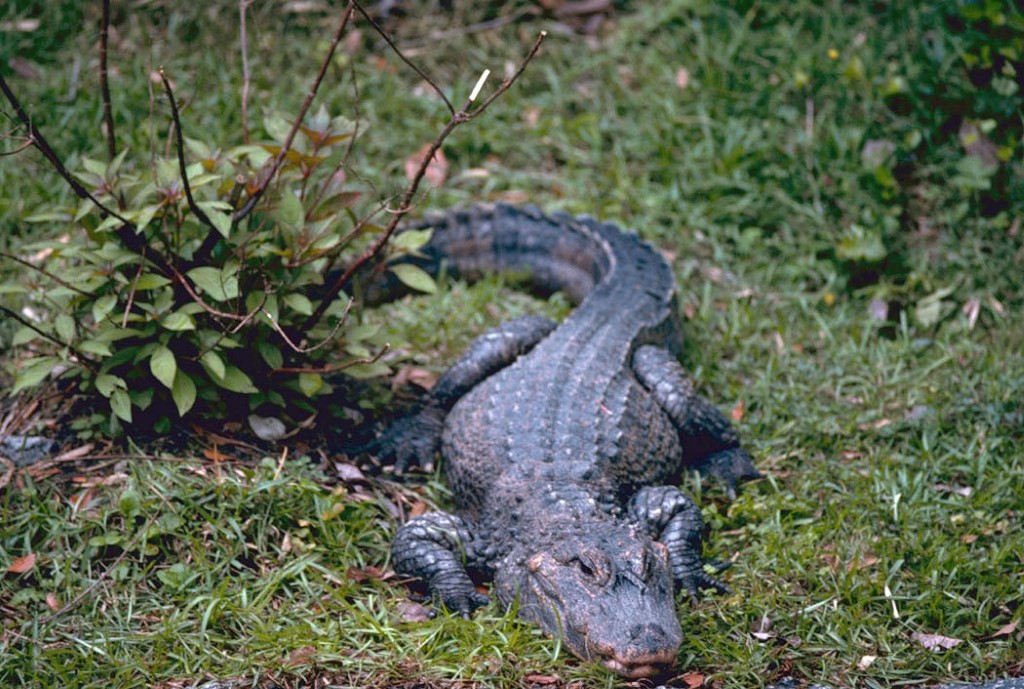 © Wikimedia.org/Stolz, Gary M., CC0
© Wikimedia.org/Stolz, Gary M., CC0
Masticophis flagellum is a species of nonvenomous colubrid snake, commonly referred to as the coachwhip or the whip snake, which is endemic to the United States and Mexico. Six subspecies are recognized, including the nominotypical subspecies. Coachwhips are thin-bodied snakes with small heads and large eyes with round pupils. They vary greatly in color, but most reflect a proper camouflage for their natural habitat. M. f. testaceus is typically a shade of light brown with darker brown flecking, but in the western area of Texas, where the soil color is a shade of pink, the coachwhips are also pink in color. M. f. piceus was given its common name because specimens frequently, but not always, have some red in their coloration. Coachwhip scales are patterned so at first glance, the snake appears braided. Subspecies can be difficult to distinguish in areas where their ranges overlap. Adult sizes of 127–183 cm (50–72 in) in total length (including tail) are common. The record sized specimen, of the eastern coachwhip race, was 259 cm (102 in) in total length. Young specimens, mostly just over 100 cm (40 in) in length, were found to have weighed 180 to 675 g (6+1⁄2 to 24 oz), whereas good-sized mature adults measuring 163 to 235 cm (64 to 93 in) weighed 1.2 to 1.8 kg (2 lb 10 oz to 3 lb 15 oz). (Source: Wikipedia.org, CC BY-SA)
Cobra is the common name of various snakes, most of which belong to the genus Naja. All of the known cobras are venomous and many are capable of rearing upwards and producing a hood when threatened. (Source: Wikipedia.org, CC BY-SA)
Collett's snake (Pseudechis colletti), also commonly known as Collett's black snake, Collett's cobra, or Down's tiger snake, is a species of venomous snake in the family Elapidae. The species is native to Australia. Although Collett's snake is not as venomous as other Australian snakes, it is capable of delivering a fatal bite, ranking nineteenth in the world's most venomous snakes. The most colourful member of the black snake genus Pseudechis, Collett's snake has dark brown to black upperparts, with pink or cream banding and sides, and pale yellow to orange underparts. The irregular bands are usually cross-shaped and are generally an orange-red colour. The underbelly is normally the same colour as the bands, but may have varied discolourisations or discoloured patches. Juveniles are usually the same colour as adults but generally have brighter shades and contrast more. It is similar in physical structure (but not appearance) to the red-bellied black snake. Collett's snake is usually between 1.8–2.2 m (5.9–7.2 ft) in total length (including tail). Males can reach up to 2.6 m (8.5 ft) in total length, while females can reach up to 2.1 m (6.9 ft). At birth, it is usually 30 cm (0.98 ft) in total length. (Source: Wikipedia.org, CC BY-SA)
Vipera berus, the common European adder or common European viper, is a venomous snake that is extremely widespread and can be found throughout most of central and eastern Europe and as far as East Asia. Known by a host of common names including common adder and common viper, adders have been the subject of much folklore in Britain and other European countries. They are not regarded as especially dangerous;[page needed] the snake is not aggressive and usually bites only when really provoked, stepped on, or picked up. Bites can be very painful, but are seldom fatal. The specific name, berus, is New Latin and was at one time used to refer to a snake, possibly the grass snake, Natrix natrix. The common adder is found in different terrains, habitat complexity being essential for different aspects of its behaviour. It feeds on small mammals, birds, lizards, and amphibians, and in some cases on spiders, worms, and insects. The common adder, like most other vipers, is ovoviviparous. Females breed once every two or three years, with litters usually being born in late summer to early autumn in the Northern Hemisphere. Litters range in size from three to 20 with young staying with their mothers for a few days. Adults grow to a total length (including tail) of 60 to 90 cm (24 to 35 in) and a mass of 50 to 180 g (1.8 to 6.3 oz)[citation needed]. Three subspecies are recognized, including the nominate subspecies, Vipera berus berus described here. The snake is not considered to be threatened, though it is protected in some countries. (Source: Wikipedia.org, CC BY-SA)
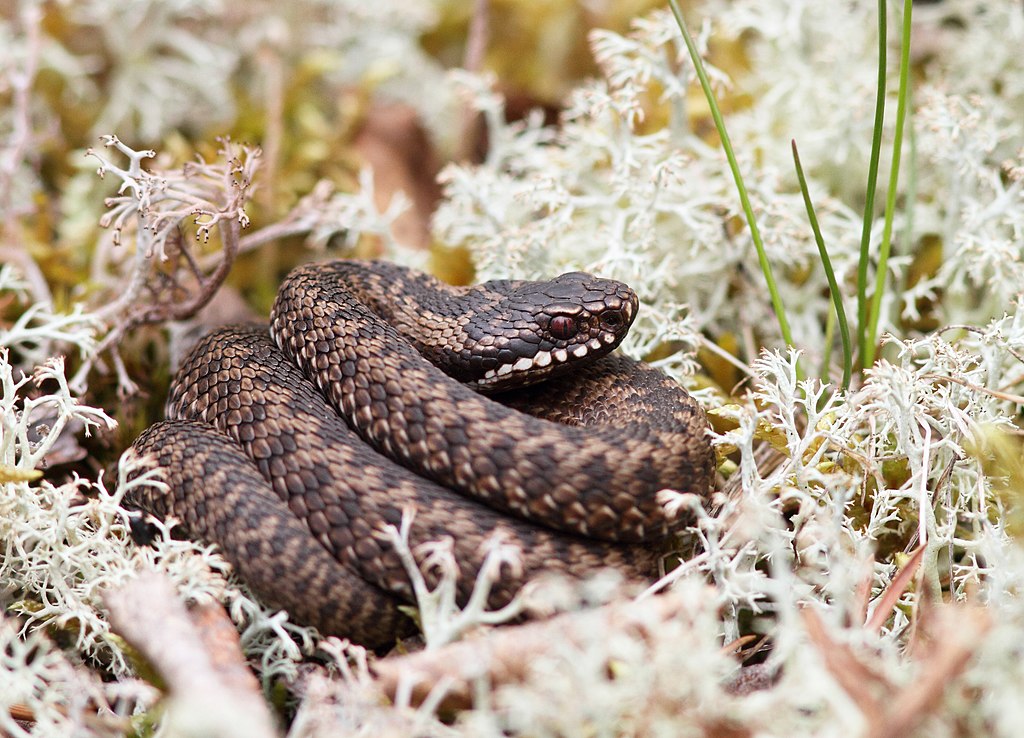 © Wikimedia.org/Bouke ten Cate, CC BY-SA
© Wikimedia.org/Bouke ten Cate, CC BY-SA
The eastern copperhead (Agkistrodon contortrix), also known as the copperhead, is a species of venomous snake, a pit viper, endemic to eastern North America; it is a member of the subfamily Crotalinae in the family Viperidae. The eastern copperhead has distinctive, dark brown, hourglass-shaped markings, overlaid on a light reddish brown or brown/gray background. The body type is heavy, rather than slender. Neonates are born with green or yellow tail tips, which progress to a darker brown or black within one year. Adults grow to a typical length (including tail) of 50–95 cm (20–37 in). In most of North America, it favors deciduous forest and mixed woodlands. It may occupy rock outcroppings and ledges, but is also found in low-lying, swampy regions. During the winter, it hibernates in dens or limestone crevices, often together with timber rattlesnakes and black rat snakes. The eastern copperhead is known to feed on a wide variety of prey, including invertebrates (primarily arthropods) and vertebrates. Like most pit vipers, the eastern copperhead is generally an ambush predator; it takes up a promising position and waits for suitable prey to arrive. As a common species within its range, it may be encountered by humans. Unlike other viperids, they often 'freeze' instead of slithering away, due to its habit of relying on excellent camouflage, rather than fleeing. Bites occur due to people unknowingly stepping on or near them. (Source: Wikipedia.org, CC BY-SA)
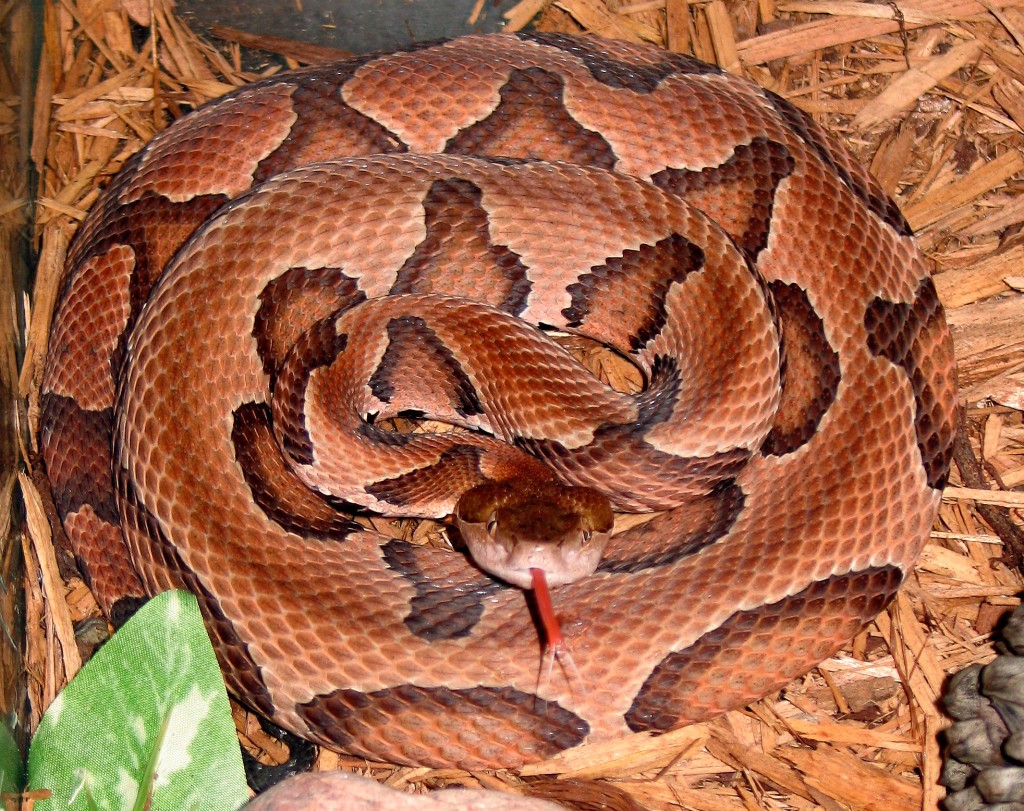 © Wikimedia.org/Public Health Image Library, CC0
© Wikimedia.org/Public Health Image Library, CC0
Coral snakes are a large group of elapid snakes that can be divided into two distinct groups, the Old World coral snakes and New World coral snakes. There are 16 species of Old World coral snakes, in three genera (Calliophis, Hemibungarus, and Sinomicrurus), and over 65 recognized species of New World coral snakes, in two genera (Micruroides and Micrurus). Genetic studies have found that the most basal lineages have origins in Asia, suggesting that the group originated in the Old World. While new world species of both genera are venomous, their bites are seldom lethal; only two confirmed fatalities have been documented in the past 100 years from the genus Micrurus. Meanwhile, snakes of the genus Micruroides have never caused a medically-significant bite. Coral snakes vary widely in their behavior, but most are very elusive, fossorial (burrowing) snakes which spend most of their time buried beneath the ground or in the leaf litter of a rainforest floor, coming to the surface only when it rains or during breeding season. Some species, like Micrurus surinamensis, are almost entirely aquatic and spend most of their lives in slow-moving bodies of water that have dense vegetation. Coral snakes feed mostly on smaller snakes, lizards, frogs, nestling birds, small rodents, etc. (Source: Wikipedia.org, CC BY-SA)
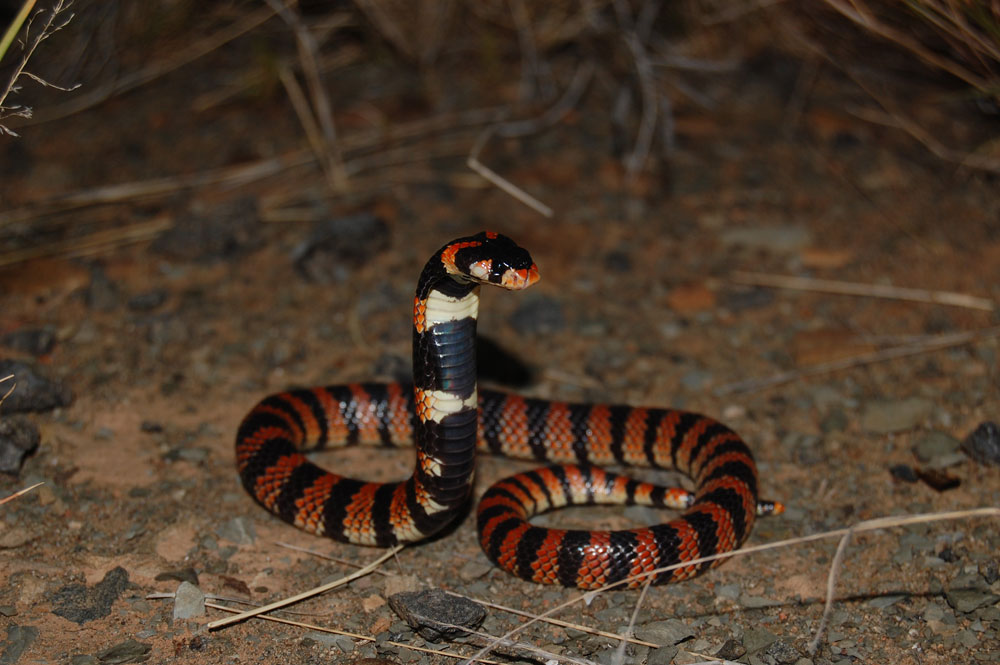 © Wikimedia.org/Ryanvanhuyssteen, CC BY-SA
© Wikimedia.org/Ryanvanhuyssteen, CC BY-SA
The corn snake (Pantherophis guttatus) is a species of North American rat snake in the family Colubridae. The species subdues its small prey by constriction. It is found throughout the southeastern and central United States. Though superficially resembling the venomous copperhead (Agkistrodon contortrix) and often killed as a result of this mistaken identity, the corn snake lacks functional venom and is harmless. The corn snake is beneficial to humans because it helps to control populations of wild rodent pests that damage crops and spread disease. As an adult the corn snake may have a total length (including tail) of 61–182 cm (2.00–5.97 ft). In the wild, it usually lives around ten to fifteen years, but in captivity can live to an age of 23 years or more. The record for the oldest corn snake in captivity was 32 years and 3 months. The corn snake can be distinguished from a copperhead by the corn snake's brighter colors, slender build, round pupils, and lack of heat-sensing pits. (Source: Wikipedia.org, CC BY-SA)
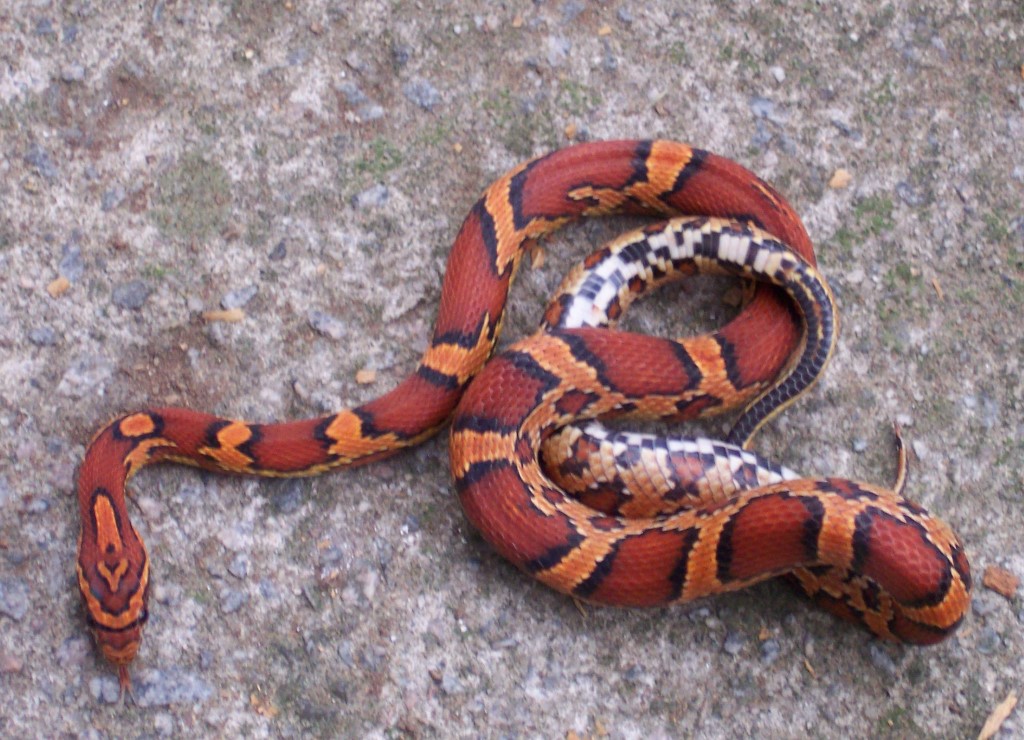 © Wikimedia.org/Jthatt~enwiki, CC BY-SA
© Wikimedia.org/Jthatt~enwiki, CC BY-SA
Agkistrodon piscivorus is a species of pit viper in the subfamily Crotalinae of the family Viperidae. It is one of the world's few semiaquatic vipers (along with the Florida cottonmouth), and is native to the southeastern United States. As an adult, it is large and capable of delivering a painful and potentially fatal bite. When threatened, it may respond by coiling its body and displaying its fangs. Individuals may bite when feeling threatened or being handled in any way. It tends to be found in or near water, particularly in slow-moving and shallow lakes, streams, and marshes. It is a capable swimmer and, like several species of snakes, is known to occasionally enter bays and estuaries and swim between barrier islands and the mainland. Agkistrodon piscivorus is the largest species of the genus Agkistrodon. Adults commonly exceed 80 cm (31 in) in total length (including tail); females are typically smaller than males. Total length, per one study of adults, was 65 to 90 cm (26 to 35 in). Average body mass has been found to be 292.5 to 579.6 g (10.32 to 20.44 oz) in males and 201.1 to 254.1 g (7.09 to 8.96 oz) in females. Occasionally, individuals may exceed 180 cm (71 in) in total length, especially in the eastern part of the range. (Source: Wikipedia.org, CC BY-SA)
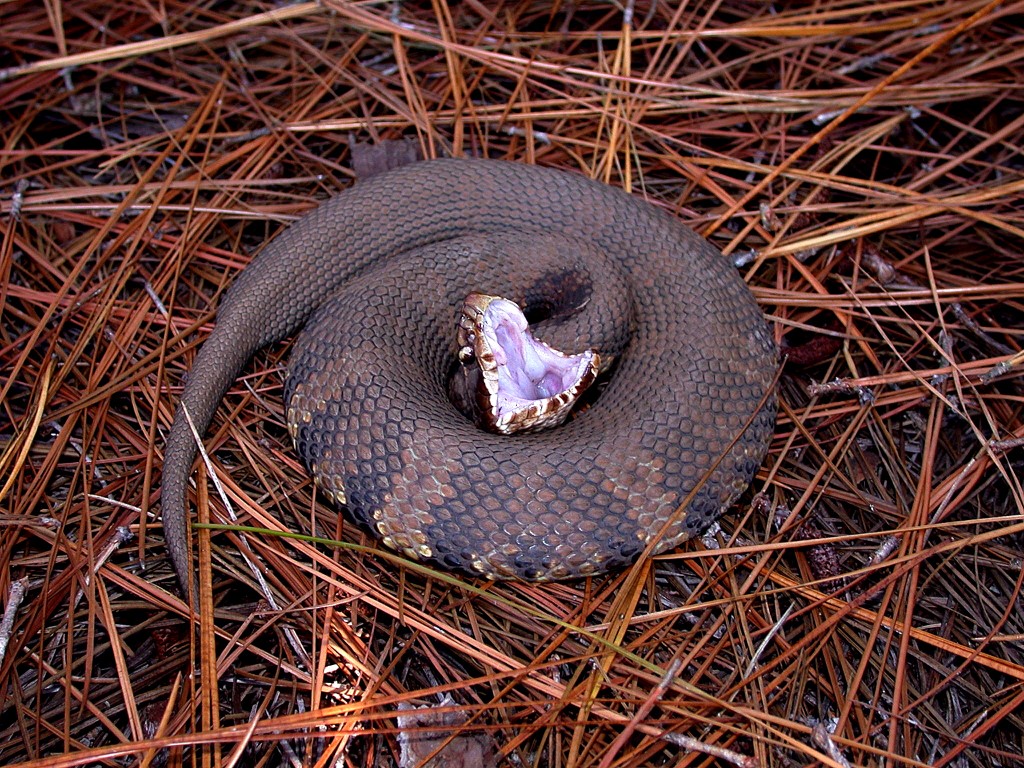 © Wikimedia.org/CDC/Edward J. Wozniak D.V.M., CC0
© Wikimedia.org/CDC/Edward J. Wozniak D.V.M., CC0
The crested gecko or eyelash gecko (Correlophus ciliatus) is a species of gecko native to southern New Caledonia. In 1866, the crested gecko was described by a French zoologist named Alphonse Guichenot. This species was thought extinct until it was rediscovered in 1994 during an expedition led by Robert Seipp. Along with several other New Caledonian gecko species, it is being considered for protected status by the Convention on the International Trade in Endangered Species of Wild Flora and Fauna. Crested geckos typically range from 6–10 inches (15–25 cm) in length, including 4–6 inches (10–15 cm) of tail length. Among the most distinctive features of these geckos are the hair-like projections found above the eyes, which greatly resemble eyelashes. This projections continue as two rows of spines that run from the eyes to the sides of their wedge-shaped head and continue to the base of their tail. Crested geckos do not have eyelids. Instead, a transparent scale, or spectacle, keeps each eye moist, and the geckos use their tongues to clear away debris. (Source: Wikipedia.org, CC BY-SA)
Crocodiles (family Crocodylidae) or true crocodiles are large semiaquatic reptiles that live throughout the tropics in Africa, Asia, the Americas and Australia. The term crocodile is sometimes used even more loosely to include all extant members of the order Crocodilia, which includes the alligators and caimans (family Alligatoridae), the gharial and false gharial (family Gavialidae) among other extinct taxa. Although they appear similar, crocodiles, alligators and the gharial belong to separate biological families. The gharial, with its narrow snout, is easier to distinguish, while morphological differences are more difficult to spot in crocodiles and alligators. The most obvious external differences are visible in the head, with crocodiles having narrower and longer heads, with a more V-shaped than a U-shaped snout compared to alligators and caimans. Another obvious trait is that the upper and lower jaws of the crocodiles are the same width, and the teeth in the lower jaw fall along the edge or outside the upper jaw when the mouth is closed; therefore, all teeth are visible, unlike an alligator, which possesses in the upper jaw small depressions into which the lower teeth fit. Also, when the crocodile's mouth is closed, the large fourth tooth in the lower jaw fits into a constriction in the upper jaw. For hard-to-distinguish specimens, the protruding tooth is the most reliable feature to define the species' family. Crocodiles have more webbing on the toes of the hind feet and can better tolerate saltwater due to specialized salt glands for filtering out salt, which are present, but non-functioning, in alligators. Another trait that separates crocodiles from other crocodilians is their much higher levels of aggression. (Source: Wikipedia.org, CC BY-SA)
The Cuban boa (Chilabothrus angulifer), also known as the Cuban tree boa and by locals as maja de Santa María, is a very large species of snake in the family Boidae. With lengths exceeding 5 m (16 ft) and a relatively heavy build, the Cuban boa is one of the largest snakes in the world. The species is native to Cuba and some nearby islands. There are no subspecies that are recognized as being valid. The presence of labial pits, the shortest tail of the entire genus and supralabials separated from the eye result in the Cuban boa being the least derived species of the genus Chilabothrus. It is also the largest member of Chilabothrus. The Cuban boa has a quite massive body, of a size typical for a boa or python of far greater length. (Source: Wikipedia.org, CC BY-SA)
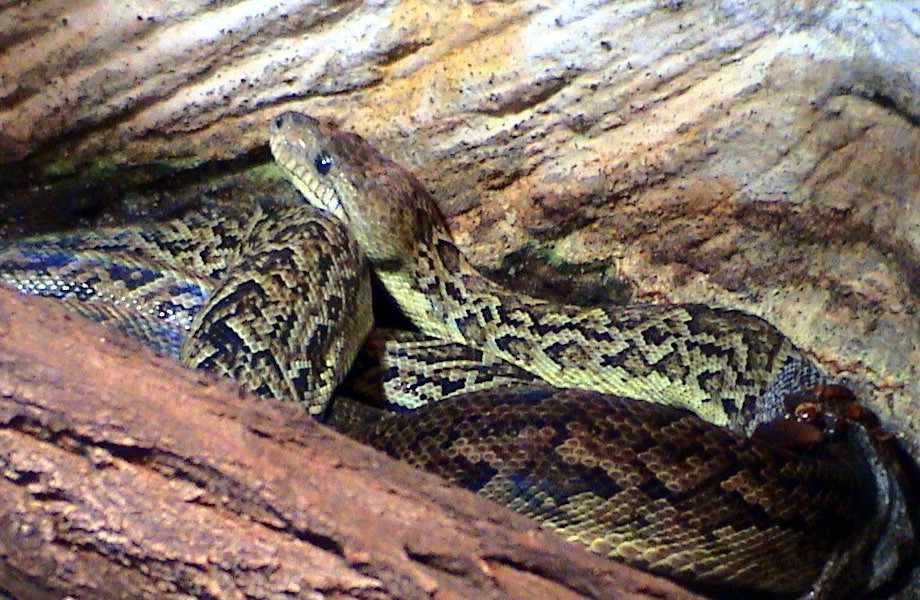 © Wikimedia.org/KaroH, CC BY-SA
© Wikimedia.org/KaroH, CC BY-SA
Acanthophis is a genus of elapid snakes. Commonly called death adders, they are native to Australia, New Guinea and nearby islands, and are among the most venomous snakes in the world. Despite their common name, they are not adders at all and belong to the Elapidae family (like cobras). The name of the genus derives from the Ancient Greek akanthos/ἄκανθος ('spine') and ophis/ὄφις ('snake'), referring to the spine on the death adder's tail. Eight species are listed by ITIS, though it remains unclear how many species this genus includes, with figures ranging from 4 to 15 species being quoted. Death adders are very viper-like in appearance, having a short, robust body, triangular shaped heads, small subocular scales, many small scales on the top of the head, and elevated supraocular scales. Dorsal scales may be smooth or keeled. Body patterning is generally crossbanding, and they have vertically elliptical pupils. Their fangs are also longer and more mobile than for most other elapids, although still far from the size seen in some of the true vipers. Despite their name, they are not related to adders, which are members of the family Viperidae, and their similar appearance is due to convergent evolution. (Source: Wikipedia.org, CC BY-SA)
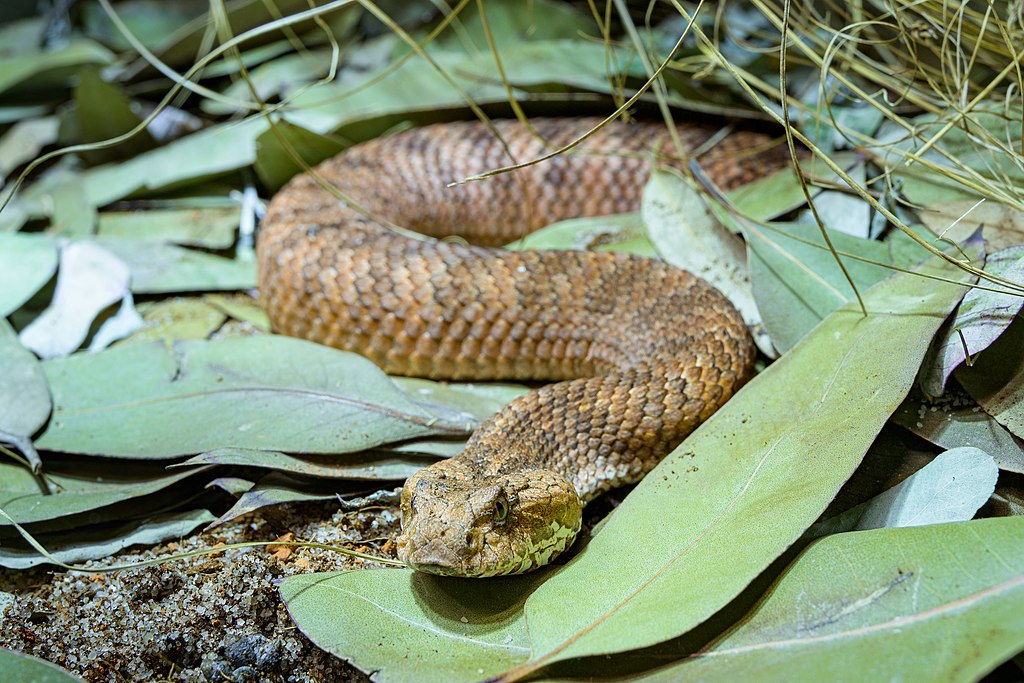 © Wikimedia.org/Petr Hamerník, CC BY-SA
© Wikimedia.org/Petr Hamerník, CC BY-SA
The desert kingsnake (Lampropeltis splendida) is a species of kingsnake native to Texas, Arizona, and New Mexico, United States. It is not venomous, colored yellow and black. The desert kingsnake's diet consists of rodents, lizards, and smaller snakes, including rattlesnakes. They normally grow 3–4 ft long, but have been known to grow up to 6.8 ft. They are docile creatures when confronted by humans. If they do not try to escape, often they 'play dead' by flipping over onto their backs and lying motionless. Some who domesticate kingsnakes, such as ranchers, do so in the hopes that the kingsnakes will feed on other snakes, which might present more of a threat. It was previously considered a subspecies of the common kingsnake. The Desert Kingsnake belongs to the Colubridae family, which is the largest family of snakes in the world. The snake's glossy dorsum is black or very dark brown colored, finely speckled with off-white or yellow. These pale flecks form dimly defined narrow vertebral crossbands, between which the intervening rectangular areas are black. Pale yellow scales may predominate along the lower sides. The abdomens of both adult and young snakes are mostly black, with white or pale yellow blotches marking the outer ends of the ventral plates. The smooth dorsal scales are arranged in 23 to 25 rows at midbody and the anal plate is undivided. (Source: Wikipedia.org, CC BY-SA)
The desert tortoise (Gopherus agassizii), is a species of tortoise in the family Testudinidae. The species is native to the Mojave and Sonoran Deserts of the southwestern United States and northwestern Mexico, and to the Sinaloan thornscrub of northwestern Mexico. G. agassizii is distributed in western Arizona, southeastern California, southern Nevada, and southwestern Utah. The specific name agassizii is in honor of Swiss-American zoologist Jean Louis Rodolphe Agassiz. The desert tortoise lives about 50 to 80 years; it grows slowly and generally has a low reproductive rate. It spends most of its time in burrows, rock shelters, and pallets to regulate body temperature and reduce water loss. It is most active after seasonal rains and is inactive during most of the year. This inactivity helps reduce water loss during hot periods, whereas winter brumation facilitates survival during freezing temperatures and low food availability. Desert tortoises can tolerate water, salt, and energy imbalances on a daily basis, which increases their lifespans. (Source: Wikipedia.org, CC BY-SA)
Draco volans, also commonly known as the common flying dragon, is a species of lizard in the family Agamidae. The species is endemic to Southeast Asia. Like other members of genus Draco, this species has the ability to glide using winglike lateral extensions of skin called patagia. Draco volans grows to a length of up to 22 cm (8.7 in), including the tail. The body is tan in color with dark flecks. The patagium of the male is tan to bright orange with dark banding. The female's patagium has irregular markings rather than banding. Draco volans feeds mainly on ants, and possibly other insects (such as termites). A study was conducted in Eastern Mindanao, Philippines, which found that the species exclusively feeds on ants. The 'wings' of D. volans are supported by its ribs, which form the skeleton of the patagia. However, its elongated ribs are superadded to aid forming its 'wings', and not to assist respiration. This species is considered a passive glider, or parachutist. However, previous studies have also shown that it can be considered a gliding animal. This means that it doesn't have to deal with the aerodynamic and metabolic imperatives required for active flight. (Source: Wikipedia.org, CC BY-SA)
Acrantophis dumerili, commonly known as Dumeril's boa, is a species of non-venomous snake in the family Boidae. The species is endemic to Madagascar. There are no subspecies that are recognized as being valid. Adults of A. dumerili usually grow to 6.5 feet (2 m) in total length (including tail) with the maximum reported to be 8 foot, 6 inches (259 cm). Males usually have longer skinnier tails, while females tend to be larger overall.[citation needed] The color pattern consists of a gray-brown ground color with darker patches, forming an effective camouflage against the leaf litter of the forest floor of their native habitat.[citation needed] The diet of A. dumerili consists of small animals, such as birds, lizards, and small mammals, including juvenile lemurs. It is also known to prey on other snakes. (Source: Wikipedia.org, CC BY-SA)
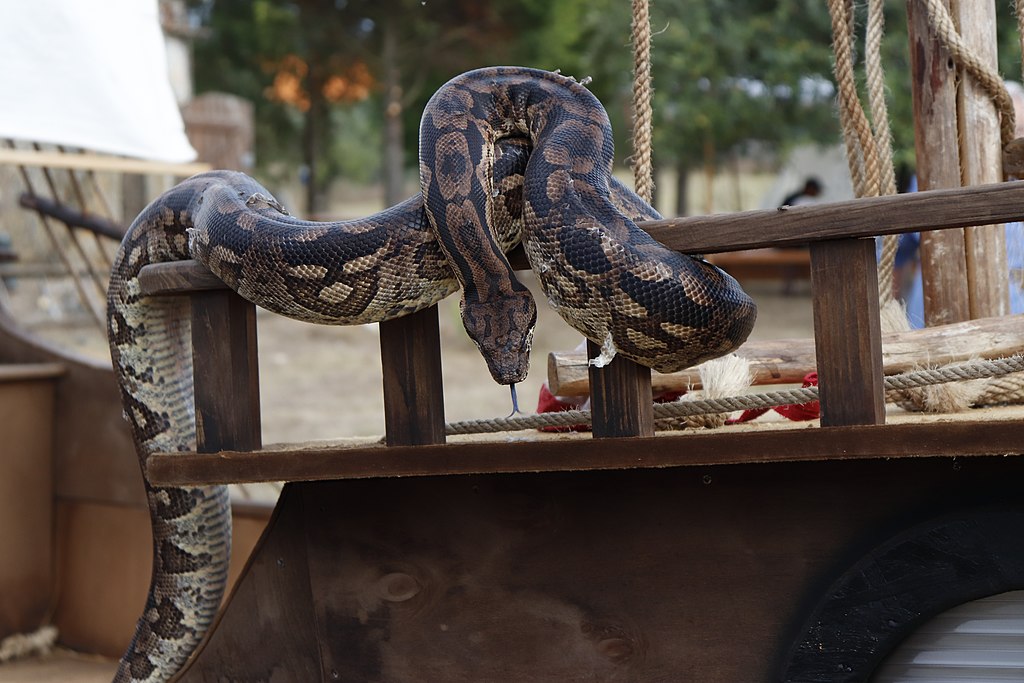 © Wikimedia.org/Ana Rita Ferreira 80, CC BY
© Wikimedia.org/Ana Rita Ferreira 80, CC BY
The Tropidophiidae, common name dwarf boas or thunder snakes, are a family of nonvenomous snakes found from Mexico and the West Indies south to southeastern Brazil. These are small to medium-sized fossorial snakes, some with beautiful and striking color patterns. Currently, two living genera, containing 34 species, are recognized. Two other genera (Ungaliophis and Exiliboa) were once considered to be tropidophiids but are now known to be more closely related to boids, and are classified in the subfamily Ungaliophiinae. There are a relatively large number of fossil snakes that have been described as tropidophiids (because their vertebrae are easy to identify), but which of these are more closely related to Tropidophis and Trachyboa and which are more closely related to Ungaliophis and Exiliboa is unknown. This family is confined to the neotropics, mainly in Hispaniola, Jamaica, and the Cayman Islands, with the greatest diversity being in Cuba, where new species are being discovered. These snakes are relatively small, averaging to about 30–60 cm (12–24 in) in total length (including tail). (Source: Wikipedia.org, CC BY-SA)
The dwarf crocodile (Osteolaemus tetraspis), also known as the African dwarf crocodile, broad-snouted crocodile (a name more often used for the Asian mugger crocodile) or bony crocodile, is an African crocodile that is also the smallest extant (living) species of crocodile. Dwarf crocodiles attain a medium adult length of 1.5 m (4.9 ft), though the maximum recorded length for this species is 1.9 m (6.2 ft). Adult specimens typically weigh between 18 and 32 kg (40 and 71 lb), with the largest females weighing up to 40 kg (88 lb) and the largest males weighing 80 kg (180 lb). This makes it the smallest living crocodile species, although the Cuvier's dwarf caiman (Paleosuchus palpebrosus), a member of the family Alligatoridae, is smaller at up to about 1.7 m (5.6 ft). If the Congo dwarf crocodile (O. osborni) is recognized as a valid species, it would be both the smallest crocodile and the smallest crocodilian since it does not surpass 1.2 m (3.9 ft). Adults are all dark above and on their sides, while the underside is yellowish with black patches. Some individuals living in the caves of Abanda, Gabon, displayed orange patches, apparently due to alkaline bat guano that erodes the skin of the crocodile. Juveniles have a lighter brown banding on body and tails and yellow patterns on the head. (Source: Wikipedia.org, CC BY-SA)
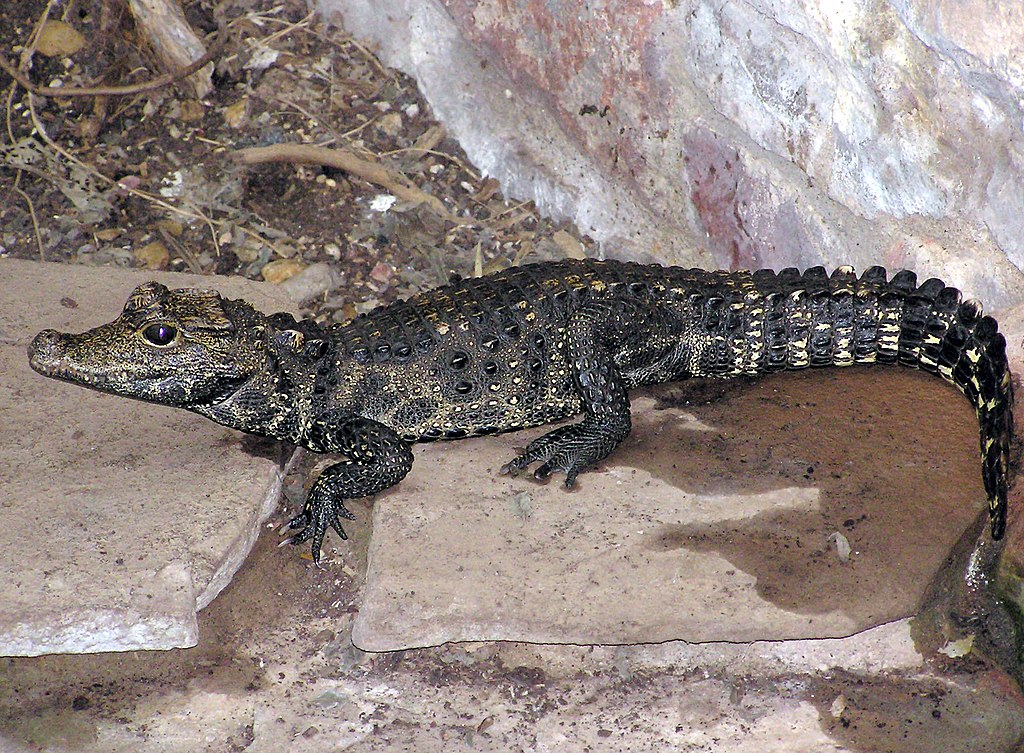 © Wikimedia.org/Adrian Pingstone, CC0
© Wikimedia.org/Adrian Pingstone, CC0
Micrurus fulvius, commonly known as the eastern coral snake, common coral snake, American cobra, and more, is a species of highly venomous coral snake in the family Elapidae. The species is endemic to the southeastern United States. It should not be confused with the scarlet snake (Cemophora coccinea) or scarlet kingsnake (Lampropeltis elapsoides), which are harmless mimics. No subspecies are currently recognized. M. fulvius is generally less than 80 cm (31 in) in total length (including tail). The maximum reported total lengths are 121.8 cm (48.0 in) for a specimen in Florida (Neill, 1958) and 129.5 cm (51.0 in) (Roze, 1996). Males have longer tails than females, but females reach a greater total length. The dorsal scales are smooth, and are in 15 rows at midbody. The ventral scales number 197–217 in males and 219–233 in females. There are 40–47 subcaudals in males and 30–37 in females. The anal plate is divided. (Source: Wikipedia.org, CC BY-SA)
The eastern diamondback rattlesnake (Crotalus adamanteus) is a species of pit viper in the family Viperidae. The species is endemic to the Southeastern United States. It is one of the heaviest venomous snakes in the Americas and the largest rattlesnake. The eastern diamondback rattlesnake is the largest rattlesnake species and is one of the heaviest known species of venomous snake, with one specimen shot in 1946 measuring 2.4 m (7.8 ft) in length and weighing 15.4 kg (34 lb). However, other venomous snakes may rival this species in weight such as the much longer but more slender king cobra and the shorter but even bulkier Gaboon viper. Maximum reported lengths for the eastern diamondback rattlesnake are 2.4 m (8 ft) and 2.5 m (8.25 ft). However, the stated maximum sizes have been called into question due to a lack of voucher specimens. Males are typically larger than females, which is rare among snakes (females are usually larger than males). (Source: Wikipedia.org, CC BY-SA)
The eastern fence lizard (Sceloporus undulatus) is a medium-sized species of lizard in the family Phrynosomatidae. The species is found along forest edges, rock piles, and rotting logs or stumps in the eastern United States. It is sometimes referred to as the prairie lizard, fence swift, gray lizard, gravid lizard, northern fence lizard or pine lizard. It is also referred to colloquially as the horn-billed lizard. One of its most notable behaviors is that of its escape behavior when encountering fire ants. The eastern fence lizard can grow from 4.0 to 7.5 inches (10 to 19 cm) in total length (including tail). It is typically colored in shades of gray or brown, and has keeled scales, with a dark line running along the rear of the thigh. A female is usually gray and has a series of dark, wavy lines across her back. The belly is white with black flecks, with some pale blue on the throat and belly. The male is usually brown, and during the summer, has a more greenish-blue and black coloration on the sides of the belly and throat than the female. The young look like the females, but are darker and duller. The lizards mostly inhabit sparsely wooded areas with ample sunlight, such as pine barrens with sandy or loose soil. They can be found basking atop of both natural and artificial structures including coarse woody debris, tree stumps, rock piles, sandy hills, dead logs, and fence posts. They are most active in the early morning sun when the ground has not been fully warmed up yet. They seek refuge inside structures when it gets too hot and at night. (Source: Wikipedia.org, CC BY-SA)
The eastern indigo snake (Drymarchon couperi) is a species of large, non-venomous snake in the family Colubridae. Native to the southeastern region of the United States, it is the longest native snake species in North America. The eastern indigo snake has uniform blue-black dorsal scales, with some specimens having a reddish-orange to tan color on the throat, cheeks, and chin. This snake received its common name from the glossy iridescent dorsal and ventral scales which can be seen as blackish-purple in bright light. This smooth-scaled snake is considered to be the longest native snake species in the United States and all of North America. The longest recorded specimen measured 2.8 m (9.2 ft) in total length (including tail). Unlike many snakes, mature male indigo snakes are slightly larger than females. This is thought to be due to intraspecies competition and combat with the males. A typical mature male measures 1.2–2.36 m (3.9–7.7 ft) in total length, with a reported average of 1.58 m (5.2 ft), and weighs 0.72–4.5 kg (1.6–9.9 lb), reportedly averaging 2.2 kg (4.9 lb). Meanwhile, a mature female typically measures around 1.1–2 m (3.6–6.6 ft) in total length, averaging 1.38 m (4.5 ft), and weighs 0.55–2.7 kg (1.2–6.0 lb), averaging 1.5 kg (3.3 lb). Specimens over 2.6 m (8.5 ft) can weigh up to 5 kg (11 lb). Although the eastern indigo snake is similar in average body mass, extremely large specimens of the bulky, co-occurring venomous eastern diamondback rattlesnake can outweigh it. (Source: Wikipedia.org, CC BY-SA)
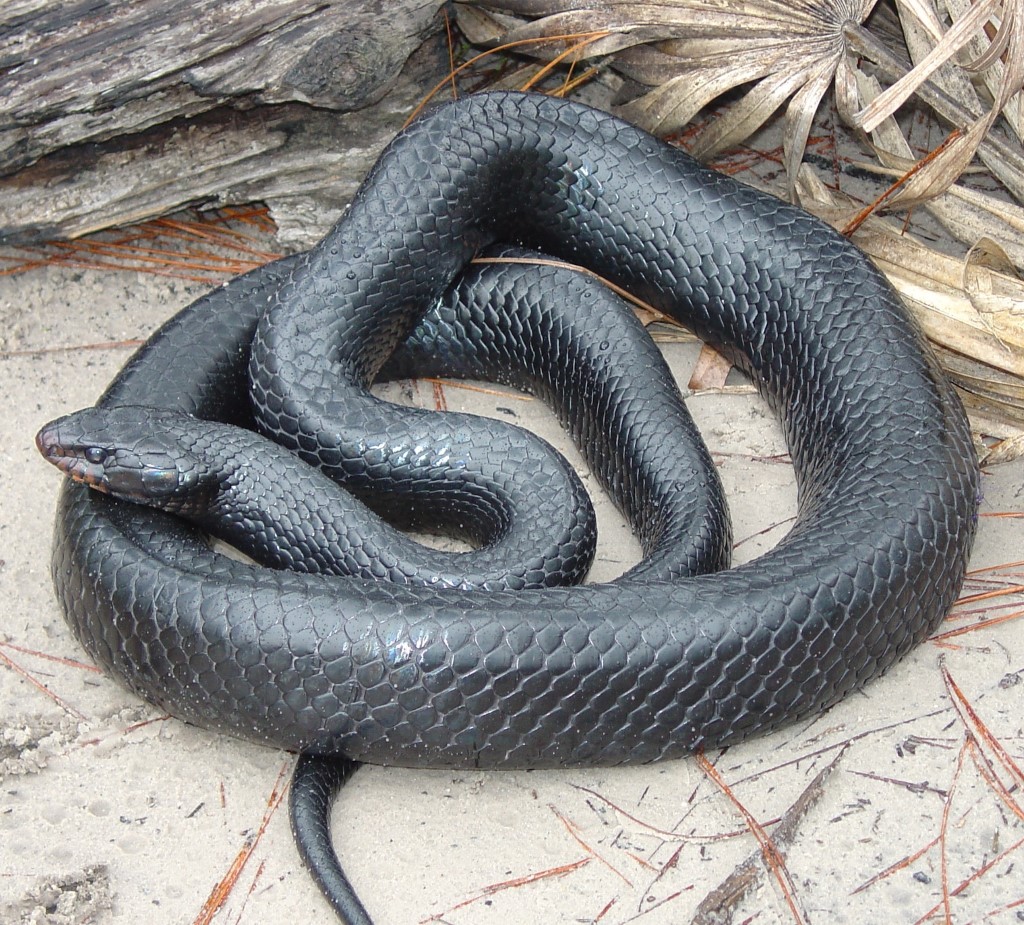 © Wikimedia.org/U.S. Army, CC0
© Wikimedia.org/U.S. Army, CC0
The eastern racer (Coluber constrictor) is a species of nonvenomous snake in the family Colubridae. The species is endemic to North America and Central America. Eleven subspecies, including the nominotypical subspecies, are recognized, which as a group are commonly referred to as the eastern racers. The species is monotypic in the genus Coluber. Adult eastern racers can typically vary from 50 to 152 cm (20 to 60 in) in total length (including tail) depending on the subspecies, but a record-sized specimen measured 185.4 cm (73.0 in) in total length. A typical adult specimen will weigh around 556 g (1.226 lb), with little size difference between the sexes. The patterns vary widely among subspecies. Most are solid-colored as their common names imply: black racers, brown racers, tan racers, blue racers, or green racers. 'Runner' is sometimes used instead of 'racer' in their common names. All subspecies have a lighter-colored underbelly: white, light tan, or yellow in color. Juveniles are more strikingly patterned, with a middorsal row of dark blotches on a light ground color. The tail is unpatterned. As they grow older, the dorsum darkens and the juvenile pattern gradually disappears. (Source: Wikipedia.org, CC BY-SA)
Pantherophis alleghaniensis, commonly called the eastern rat snake, is a species of nonvenomous snake in the family Colubridae. The species is endemic to North America. Adult eastern rat snakes commonly measure 90 to 183 cm (2 ft 11 in to 6 ft 0 in) in total length (including tail), with a few exceeding 200 cm (6 ft 7 in). The longest recorded total length to date for an eastern rat snake is 228 cm (7 ft 6 in). A sample of eastern rat snakes, including juvenile and adult snakes, weighed from 54 g (1.9 oz) to 1,274 g (2.809 lb). A further adult weighed 833 g (1.836 lb). Adults are shiny black dorsally, with a cream or white chin and throat. The belly has an irregular black and white checkerboard pattern, becoming uniformly slate gray towards the tail. Juveniles have dark dorsal blotches on a grayish ground color. The ventral pattern in juveniles is the same as in adults. The eyes are round with a black pupil, and particularly in juveniles but not always present in adults, a distinct white margin. The dorsal scales are weakly keeled, and are arranged in 23 to 27 rows at midbody. Males and females have the same coloration. Males have proportionally longer tails (16-19% of total body length) compared to females (14–18% of total body length). (Source: Wikipedia.org, CC BY-SA)
The Egyptian cobra (Naja haje), also known as Ouraeus (derived from the Ancient Greek word: οὐραῖος - Greek pronunciation: [οὐραῖος] ), is one of the most venomous snakes in North Africa, which has caused many snakebite incidents to humans. It averages roughly 1.4 metres (4.6 ft), with the longest recorded specimen measuring 2.59 metres (8.5 ft). The Egyptian cobra is a large species. The head is large and depressed and slightly distinct from the neck. The neck of this species has long cervical ribs capable of expanding to form a hood, like all other cobras. The snout of the Egyptian cobra is moderately broad and rounded. The eye is quite big with a round pupil. The body of the Egyptian cobra is cylindrical and stout, with a long tail. The length of the Egyptian cobra is largely dependent on subspecies, geographical locale, and population. The most recognizable characteristics of this species are its head and hood. The colour is highly variable, but most specimens are some shade of brown, and often a 'tear-drop' mark below the eye. Some are more copper-red or grey-brown in colour. Specimens from northwestern Africa (Morocco, Western Sahara) are almost entirely black. The ventral side is mostly a creamy white, yellow brown, grayish, blue grey, dark brown or black in colouration, often with dark spots. (Source: Wikipedia.org, CC BY-SA)
The emerald tree monitor (Varanus prasinus) or green tree monitor, is a small to medium-sized arboreal monitor lizard. It is known for its unusual coloration, which consists of shades from green to turquoise, topped with dark, transverse dorsal banding. This coloration helps camouflage it in its arboreal habitat. Its color also makes the emerald tree monitor highly prized in both the pet trade and zoos alike. The emerald tree monitor is about 75–100 cm (30–39 in) long with a slender body that helps it support itself on narrow branches. It uses its prehensile tail and long claws to grip branches. Unlike other varanids, this monitor defends its tail rather than lashing with it for defense when threatened. The soles of the feet of the emerald tree monitor have enlarged scales which aid the lizard when climbing. (Source: Wikipedia.org, CC BY-SA)
Bothriechis schlegelii, known commonly as the eyelash viper, is a species of venomous pit viper in the family Viperidae. The species is native to Central and South America. Small and arboreal, this species is characterized by a wide array of color variations, as well as the superciliary scales above the eyes. It is the most common of the green palm-pitvipers (genus Bothriechis), and is often present in zoological exhibits. The specific name schlegelii honors Hermann Schlegel, who was a German ornithologist and herpetologist. For other common names see below. No subspecies are currently recognized as being valid. The eyelash viper is a relatively small species of pitviper, with adults ranging from 55–82 cm (22–32 in) long, and females being longer and more variable in size than males, which can grow to 69 cm (27 in) long. It has a wide, triangular-shaped head, and eyes with vertical pupils. Like all pit vipers, it is solenoglyphous, having large, hypodermic needle-like fangs in the front of the upper jaw that fold back when not in use, and has heat sensitive organs, or pits, located on either side of the head between the eye and nostril. Its most distinguishing feature, and origin of its common name, is the set of modified scales above the eyes that look much like eyelashes. The eyelashes are thought to aid in camouflage, breaking up the snake's outline among the foliage where it hides. The eyelash viper occurs in a wide range of colors, including red, yellow, brown, green, even pink, as well as various combinations thereof. It often has black or brown speckling on the base color. No external features distinguish the two sexes. (Source: Wikipedia.org, CC BY-SA)
The Aniliidae are a monotypic family created for the monotypic genus Anilius that contains the single species A. scytale. Common names include American pipe snake and false coral snake. It is found in South America. This snake possesses a vestigial pelvic girdle that is visible as a pair of cloacal spurs. It is ovoviviparous. It is non-venomous, and its diet consists mainly of amphibians and other reptiles. Currently, two subspecies are recognized, including the typical form described here. This species is found in the Amazon rainforest of South America, the Guianas, and Trinidad and Tobago. It is a moderate-sized snake attaining a size of about 70 cm (28 in) in length. It is reported to be ovoviviparous and feeds on beetles, caecilians (burrowing amphibians), amphisbaenids (legless lizards), small fossorial snakes, fish, and frogs. It has a cylindrical body of uniform diameter and a very short tail; it is brightly banded in red and black and reduced eyes lie beneath large head scales. It is considered to be the snake that most resembles the original and ancestral snake condition, such as a lizard-like skull. (Source: Wikipedia.org, CC BY-SA)
Chrysopelea, more commonly known as the flying snake or gliding snake is a genus that belongs to the family Colubridae. Flying snakes are mildly venomous, though the venom is dangerous only to their small prey. Their range is in Southeast Asia (the mainland (Vietnam, Cambodia, Myanmar, and Laos), Greater and Lesser Sundas, Maluku, and the Philippines), southernmost China, India, and Sri Lanka. Chrysopelea is also known by its common name 'flying snake'. It climbs using ridge scales along its belly, pushing against the rough bark of tree trunks, allowing it to move vertically up a tree. Upon reaching the end of a branch, the snake continues moving until its tail dangles from the end of the branch. It then makes a J-shape bend, leans forward to select the level of inclination it wishes to use to control its glide path, as well as selecting a desired landing area. Once it decides on a destination, it propels itself by thrusting its body up and away from the tree, sucking in its abdomen and flaring out its ribs to turn its body into a 'pseudo concave wing', all the while making a continual serpentine motion of lateral undulation parallel to the ground to stabilise its direction in midair in order to land safely. The combination of forming a C-shape, flattening its abdomen and making a motion of lateral undulation in the air makes it possible for the snake to glide in the air, where it also manages to save energy compared to travel on the ground and dodge earth-bound predators. The concave wing that the snake creates in flattening itself nearly doubles the width of its body from the back of the head to the anal vent, which is close to the end of the snake's tail, causing the cross section of the snake's body to resemble the cross section of a frisbee or flying disc. When a flying disc spins in the air, the designed cross sectional concavity causes increased air pressure under the centre of the disc, causing lift for the disc to fly, and the snake continuously moves in lateral undulation to create the same effect of increased air pressure underneath its arched body to glide. (Source: Wikipedia.org, CC BY-SA)
Pantherophis vulpinus, commonly known as the foxsnake or the eastern fox snake, is a species of nonvenomous rat snake in the family Colubridae. The species is native to North America. Adult eastern foxsnakes are 3 to 6 feet (0.91 to 1.83 m) in total length (including tail) and have a short, flattened snout. Dorsally, they are usually light golden brown with dark brown spots and they have a yellow checkerboard pattern on the belly.[citation needed] Like most North American snakes, foxsnakes are not venomous. Foxsnakes earned their name because the musk they give off when threatened smells similar to a fox. Strong and agile, fox snakes are excellent climbers, but are more often found on the ground. Fox snakes are diurnal, but may hunt at night during the hot summer months. Like all snakes, fox snakes are cold-blooded and cannot adjust their own body temperature; so these snakes often hide in burrows or under logs or rocks to stay safe from extremely hot or cold weather. In winter, they hibernate underground, where they can avoid freezing temperatures. (Source: Wikipedia.org, CC BY-SA)
The freshwater crocodile (Crocodylus johnstoni), also known as the Australian freshwater crocodile, Johnstone's crocodile or the freshie, is a species of crocodile endemic to the northern regions of Australia. Unlike their much larger Australian relative, the saltwater crocodile, freshwater crocodiles are not known as man-eaters, although they bite in self defence, and brief, nonfatal attacks have occurred, apparently the result of mistaken identity. The freshwater crocodile is a relatively small crocodilian. Males can grow to 2.3–3.0 m (7.5–9.8 ft) long, while females reach a maximum size of 2.1 m (6.9 ft). Males commonly weigh around 70 kg (150 lb), with large specimens up to 100 kg (220 lb) or more, against the female weight of 40 kg (88 lb). In areas such as Lake Argyle and Katherine Gorge, a handful of confirmed 4 metres (13 ft) individuals exist. This species is shy and has a slenderer snout and slightly smaller teeth than the dangerous saltwater crocodile. The body colour is light brown with darker bands on the body and tail—these tend to be broken up near the neck. Some individuals possess distinct bands or speckling on the snout. Body scales are relatively large, with wide, close-knit, armoured plates on the back. Rounded, pebbly scales cover the flanks and outsides of the legs. (Source: Wikipedia.org, CC BY-SA)
The frilled lizard (Chlamydosaurus kingii), also known commonly as the frill-necked lizard, is a species of lizard in the family Agamidae. It is endemic to northern Australia and southern New Guinea. This species is the only member of the genus Chlamydosaurus. Its common names come from the large frill around its neck, which usually stays folded against the lizard's body. C. kingii is largely arboreal, spending the majority of its time in the trees. Its diet consists mainly of insects and small vertebrates. Frilled lizards, or 'frillies' as some call them, will occasionally eat plants as well, although this behaviour is uncommon. It is a relatively large lizard, averaging 85 cm (2.79 ft) in total length (including tail) and is kept as an exotic pet. The frilled lizard grows to around 85 cm (33 in), and reaches a weight of 870 g (31 oz) for males and 400 g (14 oz) for females. It is relatively robust and long-legged, and its tail makes most of its body length. The corners of its eyes are pointed, while the rounded nostrils face away from each other and angled downwards. It has long teeth in the front adapted for puncturing, while further back they are smaller with a cutting surface. Frilled lizards have sharp claws which allow them to climb trees. Most of the lizard's scales are rough. From the backbone to the sides, the scales alternate in size between small and large. (Source: Wikipedia.org, CC BY-SA)
The Gaboon viper (Bitis gabonica), also called the Gaboon adder, is a viper species found in the rainforests and savannas of sub-Saharan Africa. Like all other vipers, it is venomous. It is the largest member of the genus Bitis, and it has the longest fangs of any venomous snake – up to 2 inches (5 cm) in length – and the highest venom yield of any snake. No subspecies are recognized. Adults are typically 125–155 cm (4 to 5 ft) in total length (body and tail) with a maximum total length of 205 cm (81 in) for a specimen collected in Sierra Leone. The sexes may be distinguished by the length of the tail in relation to the total length of the body: around 12% for males and 6% for females. Adults, especially females, are very heavy and stout. The color pattern is striking in the open, but in nature, typically among dead leaves under trees, it provides a high degree of camouflage; in a well-kept cage with a suitable base of dried leaves, overlooking several fully exposed specimens completely is easy.[citation needed] The pattern consists of a series of pale, subrectangular blotches running down the center of the back, interspaced with dark, yellow-edged, hourglass markings. The flanks have a series of fawn or brown rhomboidal shapes, with light vertical central bars. The belly is pale with irregular brown or black blotches. The head is white or cream with a fine, dark central line, black spots on the rear corners, and a dark blue-black triangle behind and below each eye. The iris colour is cream, yellow-white, orange, or silvery. (Source: Wikipedia.org, CC BY-SA)
The Galápagos tortoise or Galápagos giant tortoise (Chelonoidis niger) is a species of very large tortoise in the genus Chelonoidis (which also contains three smaller species from mainland South America). It comprises 15 subspecies (13 extant and 2 extinct). It is the largest living species of tortoise, with some modern Galápagos tortoises weighing up to 417 kg (919 lb). With lifespans in the wild of over 100 years, it is one of the longest-lived vertebrates. Captive Galapagos tortoises can live up to 177 years. For example, a captive individual, Harriet, lived for at least 175 years. Spanish explorers, who discovered the islands in the 16th century, named them after the Spanish galápago, meaning 'tortoise'. The tortoises have a large bony shell of a dull brown or grey color. The plates of the shell are fused with the ribs in a rigid protective structure that is integral to the skeleton. Lichens can grow on the shells of these slow-moving animals. Tortoises keep a characteristic scute (shell segment) pattern on their shells throughout life, though the annual growth bands are not useful for determining age because the outer layers are worn off with time. A tortoise can withdraw its head, neck, and fore limbs into its shell for protection. The legs are large and stumpy, with dry, scaly skin and hard scales. The front legs have five claws, the back legs four. (Source: Wikipedia.org, CC BY-SA)
Garter snake is a common name for generally harmless, small to medium-sized snakes belonging to the genus Thamnophis in the family Colubridae. Native to North and Central America, species in the genus Thamnophis can be found from the subarctic plains of Canada to Costa Rica. With about 35 recognized species and subspecies, garter snakes are highly variable in appearance. They generally have large round eyes, round pupils, a slender build, keeled scales, and a pattern of longitudinal stripes that may or may not include spots (although some have no stripes at all). They also vary significantly in total length from as short as 18″ to as long as 51" (45-130cm). Garter snakes have complex systems of pheromonal communication. They can find other snakes by following their pheromone-scented trails. Male and female skin pheromones are so different as to be immediately distinguishable. However, male garter snakes sometimes produce both male and female pheromones. During the mating season, this ability fools other males into attempting to mate with them. This causes the transfer of heat to them in kleptothermy, which is an advantage immediately after hibernation, allowing them to become more active. Male snakes giving off both male and female pheromones have been shown to garner more copulations than normal males in the mating balls that form at the den when females enter the mating melee. A snake hatch can include as many as 57 young. (Source: Wikipedia.org, CC BY-SA)
Geckos are small, mostly carnivorous lizards that have a wide distribution, found on every continent except Antarctica. Belonging to the infraorder Gekkota, geckos are found in warm climates throughout the world. They range from 1.6 to 60 centimetres (0.6 to 23.6 inches). Geckos are unique among lizards for their vocalisations, which differ from species to species. Most geckos in the family Gekkonidae use chirping or clicking sounds in their social interactions. Tokay geckos (Gekko gecko) are known for their loud mating calls, and some other species are capable of making hissing noises when alarmed or threatened. They are the most species-rich group of lizards, with about 1,500 different species worldwide. The New Latin gekko and English 'gecko' stem from the Indonesian-Malay gēkoq, which is imitative of sounds that some species make. All geckos, except species in the family Eublepharidae lack eyelids; instead, the outer surface of the eyeball has a transparent membrane, the cornea. They have a fixed lens within each iris that enlarges in darkness to let in more light. Since they cannot blink, species without eyelids generally lick their own corneas when they need to clear them of dust and dirt, in order to keep them clean and moist. (Source: Wikipedia.org, CC BY-SA)

Time for recess! Post a comment, ask a question or write a review. Feel free to let us know what you think!
Gut zu wissen, dass es das, z.B. in Deutschland übliche gelb/weiße Schild "Vorfahrtsstraße", so nicht gibt bzw. das durch andere Zeichen geregelt wird. Ich las jedoch auch, dass Benutzer einer sog. Durchgangsstraße Vorfahrt haben. Wie ist solch eine Straße definiert?
was bedeutet rechts oder links übergabe.für mich ist es eine Strassenteilung re oder li
In Malaysia gibt es gelbe und weiße Linien zum Begrenzen der Fahrbahnen. Was bedeutet eine weiße Linie und eine gelbe Linie im Zusammenhang mit dem Halten/Parken eines Autos. innerhalb einer Ortschaft?
Fehler: "Rechtsübergabe". Okay, dieser Test ist komplett unbrauchbar. Reine Zeitschwendung.
Fehler: Bei einem Richtungswegweiser ist die erwartete Antwort: "Informationen zum Ziel der Rampe.".
Fehler: Ein dreieckiges Schild mit einem Fahrrad ist eine Warnung *vor* Radfahrern. Keine Warnung *für* Radfahrern.
An sich ganz hilfreich, aber bei einem so sensiblen Thema die Texte dermaßen schlecht zu übersetzen, geht gar nicht! Die Antwortmöglichkeiten sind so verwirrend geschrieben, daß ich teilweise nicht wußte, was gemeint war, und dementsprechend Fehler kassiert habe. Ich biete mich hiermit an, die Übersetzungen zu überarbeiten.
Dear future partners! We are European manufacturers and distributors of buoys designed to serve road and highway maintenance, driver training and sports purposes. We kindly recommend our spaces to your attention at www. lorinciboja.hu website. if you have any questions, don't hesitate to contact us at info@lorincibolya.hu or at 36 20412 8898! Have a successful trip and days! Best regards! Imre Buczkó Manager
Es ist toll, dass es diesen Test / Seite gibt. Es sind doch viele Zeichen dabei die es so in Deutschland nicht gibt. MFG Franz
Liebe Parker und ParkerINNEN, die elektronische Parkscheibe oder Parkuhr ist so viel ich weiss, seit 2005 zugelassenen und doch zahlen wir lieber die Knöllchen zwischen 25 und über 40 EURO und ärgert sich ein Weilchen darüber. Ich bin nach der letzten Zahlung von 42 Euro endlich dem Rat unseres Dorfpolizisten gefolgt und habe mir eine elektronische Parkscheibe ins Auto geklebt. Die Uhr zeigt die Ankunftszeit beim Halt an der Parkstelle nach 20 Sekunden an. Ankunft 9:55=10:00 Uhr Ankunft 10:12=10:30 Uhr vor Ankunft 10:26=10:30 Uhr Ankunft 10:34=11:00 Uhr genau so soll man ja ďa gewohnte Parkscheibe auch einstellen Übrigens, die Kennzeichen am Auto sind heutzutage nicht mehr gegen Diebstahl gesichert, es ist ratsam die Teile mit Schrauben oder Nieten zu befestigen. Ich spreche aus leidvoller Erfahrung. MfG Günter Arlt
Bitte schreiben sie die Antworten in einem richtigen Deutsch. Sie sind so sehr verwirrend und man kann sie nicht verstehen.
Gostaria de saber se alguém tem as regras de trânsito em português. Não somente as placas de trânsito mas também as situações reais.
Auf Teneriffa ist es so, wenn die Markierungen schräg aufgezeichnet sind, dann muss Rückwärts eingeparkt werden. Sonst wird es mit bis zu 90,00€ geahndet.